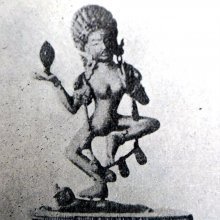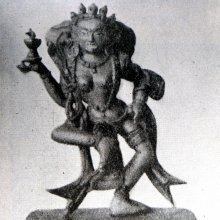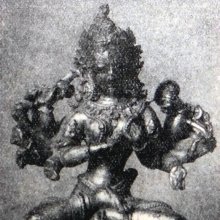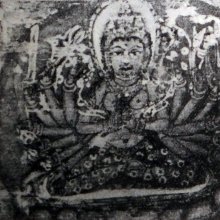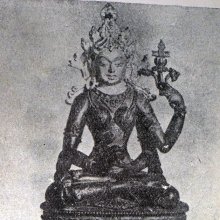Ratnolka, Ratnolkā: 6 definitions
Introduction:
Ratnolka means something in Buddhism, Pali, Hinduism, Sanskrit. If you want to know the exact meaning, history, etymology or English translation of this term then check out the descriptions on this page. Add your comment or reference to a book if you want to contribute to this summary article.
Images (photo gallery)
(+1 more images available)
In Buddhism
Tibetan Buddhism (Vajrayana or tantric Buddhism)
Source: archive.org: The Indian Buddhist Iconography1) Ratnolkā (रत्नोल्का) refers to one of the twelve Dhāriṇīs according to the 11th-century Niṣpannayogāvalī of Mahāpaṇḍita Abhayākara.—Dhāriṇī is a peculiar kind of Buddhist literature which is supposed to generate great mystic power if repeated continually for a long time. They are short works mostly composed of meaningless syllables, sometimes revealing traces of a language now defunct. [...] The deification of books is not unknown in Buddhism. [...] The Niṣpannayogavālī acknowledges altogether twelve Dhāriṇī (viz., Ratnolkā) deities and gives their descriptions. These Dhāriṇīs look alike when represented and they are usually two-armed, holding the Viśvavajra in the right hand and their special symbols in the left.
Ratnolkā is described in the Niṣpannayogāvalī (dharmadhātuvāgīśvara-maṇḍala) as follows:—
“Ratnolkā is red in colour and in her left hand she holds the cintāmaṇi banner”.
[Her Colour is red; her Symbol is the cintāmaṇi banner; she has two arms.—When conceived in the form of deities, the Dhāriṇīs (viz., Ratnolkā) are endowed with one face and two arms. They all hold in their right hand the double thunderbolt or the viśvavajra, while in the left they carry their own special symbols.]
2) Ratnolkā (रत्नोल्का) refers to one of the four “Light Goddesses”, according to the same Niṣpannayogāvalī.—Her Colour is yellow; her Symbol is the jewel; she has two arms.—The third in the series of four goddesses of Light is called Ratnolkā. [...] She is represented in the Chinese collection under the name of Ulkādharā.
Ratnolkā is described in the Niṣpannayogāvalī (pañcaḍāka-maṇḍala ) as follows:—
Source: academia.edu: The Structure and Meanings of the Heruka Maṇḍala“Ratnolkā is yellow in colour and holds the jewel in her hands”.
[Collectively, they are conceived as nude, and as violent in appearance with garland of skulls and severed heads. They dance on a corpse in the pratyālīḍha attitude and hold their special marks of recognition in their hands.]
Ratnolka (रत्नोल्क) is the name of a Vīra (hero) who, together with the Ḍākinī named Ratnolkī forms one of the 36 pairs situated in the Hṛdayacakra, according to the 10th century Ḍākārṇava chapter 15. Accordingly, the hṛdayacakra refers to one of the four divisions of the sahaja-puṭa (‘innate layer’), situated within the padma (lotus) in the middle of the Herukamaṇḍala. The 36 pairs of Ḍākinīs and Vīras [viz., Ratnolka] are reddish yellow in color; they each have one face and four arms; they hold a skull bowl, a skull staff, a small drum, and a knife.

Tibetan Buddhism includes schools such as Nyingma, Kadampa, Kagyu and Gelug. Their primary canon of literature is divided in two broad categories: The Kangyur, which consists of Buddha’s words, and the Tengyur, which includes commentaries from various sources. Esotericism and tantra techniques (vajrayāna) are collected indepently.
Languages of India and abroad
Sanskrit dictionary
Source: Cologne Digital Sanskrit Dictionaries: Edgerton Buddhist Hybrid Sanskrit DictionaryRatnolkā (रत्नोल्का).—(1) name of a goddess: Mahāvyutpatti 4287; (2) name of a work: Mahāvyutpatti 1375; in Śikṣāsamuccaya (2.15 etc.) called °kā-dhāraṇī.
Source: Cologne Digital Sanskrit Dictionaries: Monier-Williams Sanskrit-English DictionaryRatnolkā (रत्नोल्का):—[from ratna] f. Name of a Tantra deity, [Buddhist literature]
[Sanskrit to German]
Sanskrit, also spelled संस्कृतम् (saṃskṛtam), is an ancient language of India commonly seen as the grandmother of the Indo-European language family (even English!). Closely allied with Prakrit and Pali, Sanskrit is more exhaustive in both grammar and terms and has the most extensive collection of literature in the world, greatly surpassing its sister-languages Greek and Latin.
See also (Relevant definitions)
Full-text: Ulkadhara, Ratnolki, Hridayacakra, Dharini.
Relevant text
Search found 1 books and stories containing Ratnolka, Ratnolkā; (plurals include: Ratnolkas, Ratnolkās). You can also click to the full overview containing English textual excerpts. Below are direct links for the most relevant articles:
